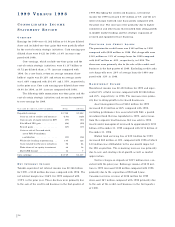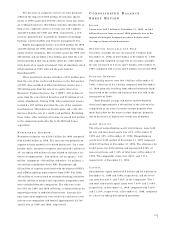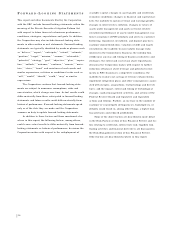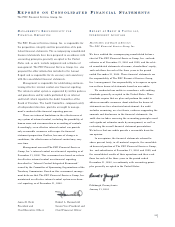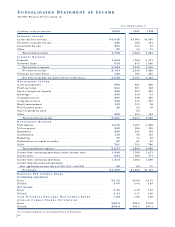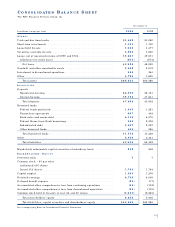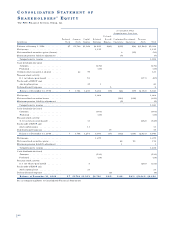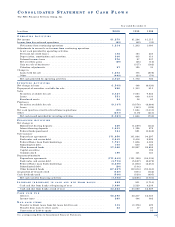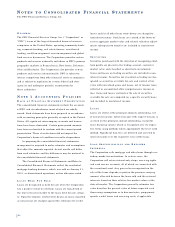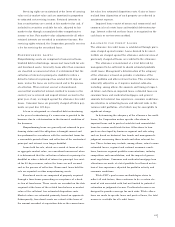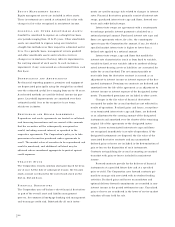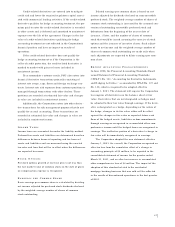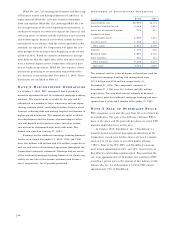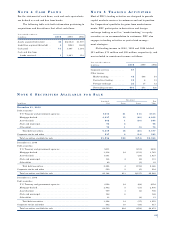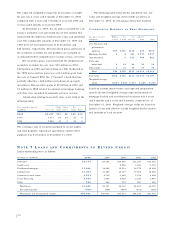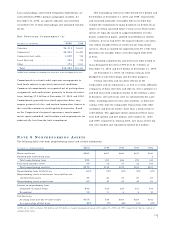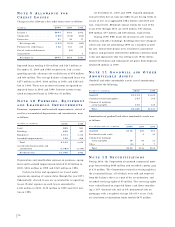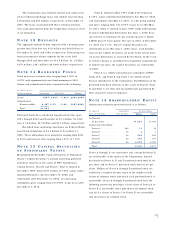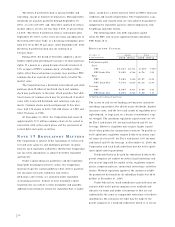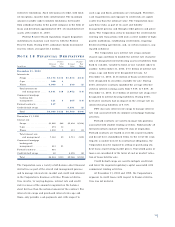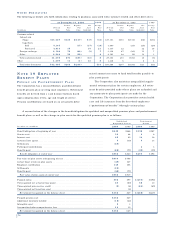PNC Bank 2000 Annual Report Download - page 69
Download and view the complete annual report
Please find page 69 of the 2000 PNC Bank annual report below. You can navigate through the pages in the report by either clicking on the pages listed below, or by using the keyword search tool below to find specific information within the annual report.
66
EQ U I T Y MA N A G E M E N T AS S E T S
Equity management assets are included in other assets.
These investments are carried at estimated fair value with
changes in fair value recognized in noninterest income.
GO O D W I L L A N D OT H E R AM O R T I Z A B L E AS S E T S
Goodwill is amortized to expense on a straight-line basis
over periods ranging from 15 to 25 years. Other amortizable
assets are amortized to expense using accelerated or
straight-line methods over their respective estimated useful
lives. On a periodic basis, management reviews goodwill
and other amortizable assets and evaluates events or
changes in circumstances that may indicate impairment in
the carrying amount of such assets. In such instances,
impairment, if any, is measured on a discounted future cash
flow basis.
DE P R E C I AT I O N A N D AM O R T I Z AT I O N
For financial reporting purposes, premises and equipment
are depreciated principally using the straight-line method
over the estimated useful lives ranging from one to 39 years.
Accelerated methods are used for federal income tax pur-
poses. Leasehold improvements are amortized over their
estimated useful lives or the respective lease terms,
whichever is shorter.
RE P U R C H A S E A N D RE S A L E AG R E E M E N T S
Repurchase and resale agreements are treated as collateral-
ized financing transactions and are carried at the amounts
that the securities will be subsequently reacquired or
resold, including accrued interest, as specified in the
respective agreements. The Corporation’s policy is to take
possession of securities purchased under agreements to
resell. The market value of securities to be repurchased and
resold is monitored, and additional collateral may be
obtained where considered appropriate to protect against
credit exposure.
TR E A S U R Y ST O C K
The Corporation records common stock purchased for treas-
ury at cost. At the date of subsequent reissue, the treasury
stock account is reduced by the cost of such stock on the
first-in, first-out basis.
FI N A N C I A L DE R I V A T I V E S
The Corporation uses off-balance-sheet financial derivatives
as part of the overall asset and liability management
process, for commercial mortgage banking risk management
and to manage credit risk. Substantially all such instru-
ments are used to manage risk related to changes in interest
rates. Financial derivatives primarily consist of interest rate
swaps, purchased interest rate caps and floors, forward con-
tracts and credit default swaps.
Interest rate swaps are agreements with a counterparty
to exchange periodic interest payments calculated on a
notional principal amount. Purchased interest rate caps and
floors are agreements where, for a fee, the counterparty
agrees to pay the Corporation the amount, if any, by which a
specified market interest rate is higher or lower than a
defined rate applied to a notional amount.
Interest rate swaps, caps and floors that modify the
interest rate characteristics (such as from fixed to variable,
variable to fixed, or one variable index to another) of desig-
nated interest-bearing assets or liabilities are accounted for
under the accrual method. The net amount payable or
receivable from the derivative contract is accrued as an
adjustment to interest income or interest expense of the des-
ignated instrument. Premiums on contracts are deferred and
amortized over the life of the agreement as an adjustment to
interest income or interest expense of the designated instru-
ments. Unamortized premiums are included in other assets.
Changes in the fair value of financial derivatives
accounted for under the accrual method are not reflected in
results of operations. Realized gains and losses, except loss-
es on terminated interest rate caps and floors, are deferred
as an adjustment to the carrying amount of the designated
instruments and amortized over the shorter of the remaining
original life of the agreements or the designated instru-
ments. Losses on terminated interest rate caps and floors
are recognized immediately in results of operations. If the
designated instruments are disposed, the fair value of the
associated derivative contracts and any unamortized
deferred gains or losses are included in the determination of
gain or loss on the disposition of such instruments.
Contracts not qualifying for accrual accounting are marked
to market with gains or losses included in noninterest
income.
Forward contracts provide for the delivery of financial
instruments at a specified future date and at a specified
price or yield. The Corporation uses forward contracts pri-
marily to manage risk associated with its student lending
activities. Realized gains and losses on mandatory and
optional delivery forward commitments are recorded in non-
interest income in the period settlement occurs. Unrealized
gains or losses are considered in the lower of cost or market
valuation of loans held for sale.


